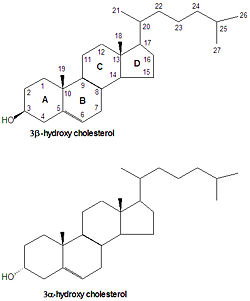Cholesterol: Difference between revisions
Jump to navigation
Jump to search

imported>David E. Volk m (other treatments:bile acid sequestrants, fibric acid derivatives, and plant stanols) |
imported>David E. Volk (move picture of cholesterol to this article, remove from steroid) |
||
| Line 1: | Line 1: | ||
{{subpages}} | {{subpages}} | ||
[[Image:Cholesterol structure nomenclature DEVolk.jpg|right|thumb|250px|{{#ifexist:Template:Cholesterol structure nomenclature DEVolk.jpg/credit|{{Cholesterol structure nomenclature DEVolk.jpg/credit}}<br/>|}}Structure and nomenclature of cholesterol. All steroid nomenclature is based on cholesterol. By convention, substituents pointing up, like C-18 and C-19, are called <math>\beta</math> while those pointing down are called <math>\alpha</math>.]] | |||
'''Cholesterol''' is a [[lipid]] that is the "principal sterol of all higher animals, distributed in body tissues, especially the brain and spinal cord, and in animal fats and oils."<ref>{{MeSH}}</ref> | '''Cholesterol''' is a [[lipid]] that is the "principal sterol of all higher animals, distributed in body tissues, especially the brain and spinal cord, and in animal fats and oils."<ref>{{MeSH}}</ref> | ||
Revision as of 13:29, 27 March 2008
Cholesterol is a lipid that is the "principal sterol of all higher animals, distributed in body tissues, especially the brain and spinal cord, and in animal fats and oils."[1]
Disorders of cholesterol
Hypercholesterolemia may contribute to coronary heart disease, stroke, and other complications. Hypercholesterolemia may be treated by medications such as statins, bile acid sequestrants, fibric acid derivatives, and plant stanols.
Hypoalphalipoproteinemia is abnormally low levels of alpha-lipoproteins (high-density lipoproteins) in the blood. Low levels of high-density lipoproteins in the blood is a component of the metabolic syndrome.
References
- ↑ Anonymous (2025), Cholesterol (English). Medical Subject Headings. U.S. National Library of Medicine.


